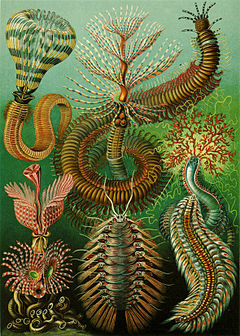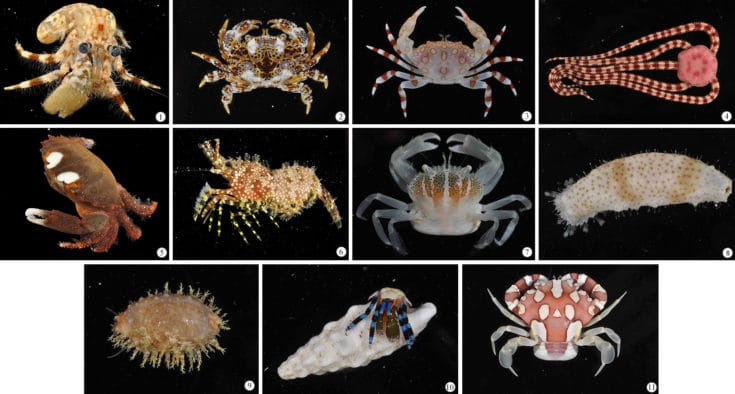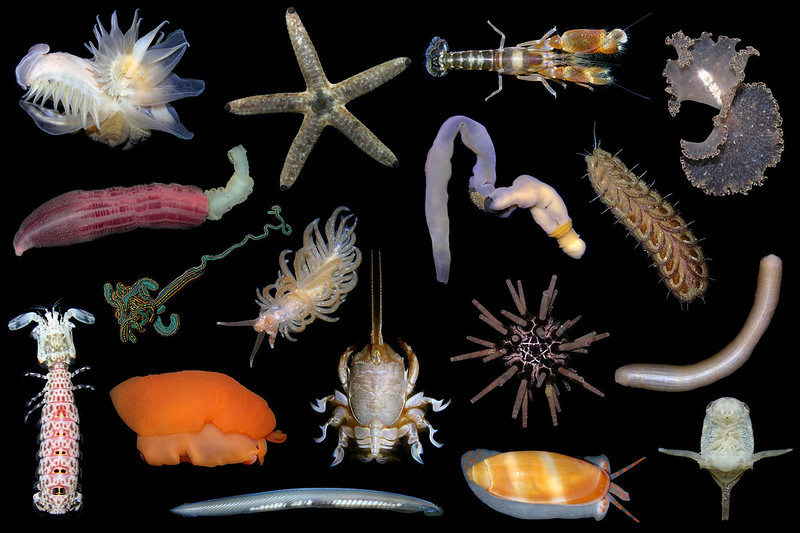Topic invertebrate marine: Dive into the enchanting realm of invertebrate marine life, where a kaleidoscope of creatures shapes our oceans" vast and vibrant ecosystems, offering a window into an underwater world brimming with wonders and scientific marvels.
Table of Content
- What are some examples of marine invertebrates?
- Overview of Marine Invertebrates
- Major Groups of Marine Invertebrates
- Economic and Ecological Significance
- Geographical Distribution and Habitat
- Role in Nutrient Cycling
- Conservation Challenges
- YOUTUBE: Unique Jam Packed Invertebrate Reef Tank
- Research and Education Resources
- Global Research Collections and Taxonomic Groups
- Future Directions in Marine Invertebrate Studies
What are some examples of marine invertebrates?
Some examples of marine invertebrates include:
- Acoela - among the most primitive bilateral animals
- Annelida - including polychaetes and sea leeches
- Brachiopoda - marine animals that have a shell-like structure
- Mollusks - a diverse group that includes creatures like clams, snails, and octopuses
- Crustaceans - including crabs, lobsters, and shrimp
- Corals - marine animals that form reefs and provide habitats for other organisms
READ MORE:
Overview of Marine Invertebrates
Marine invertebrates, encompassing a vast array of species, are fascinating creatures that play crucial roles in marine ecosystems. These organisms, which lack a vertebral column, exhibit a wide range of body plans and adaptations, allowing them to thrive in diverse marine environments.
- Evolutionary History: The development of marine invertebrates" body plans has been a gradual process, with significant diversification occurring since the Cambrian explosion.
- Taxonomic Diversity: Invertebrates form the majority of macroscopic life in marine settings. They span numerous phyla, each representing unique morphological and developmental characteristics.
- Key Groups: Major groups include sponges, cnidarians, various worms, mollusks, arthropods, echinoderms, and many others, each contributing uniquely to the marine food web and habitat structure.
- Echinodermata: A notable phylum, Echinodermata, includes species like sea stars and sea urchins, recognized for their radial symmetry and a unique water vascular system used for movement and feeding.
- Ecological Roles: Many invertebrates are crucial in nutrient cycling, acting as decomposers, filter feeders, and prey for other marine animals. For example, sea cucumbers play a significant role in coral reef ecosystems as benthic scavengers.
- Geographical Distribution: These invertebrates inhabit various marine habitats, from shallow coastal waters to the deep sea, adapting to different environmental conditions such as temperature, salinity, and depth.
Understanding marine invertebrates is vital for maintaining healthy marine ecosystems, as they contribute significantly to biodiversity and ecological balance.

Major Groups of Marine Invertebrates
Marine invertebrates represent an incredible diversity of life forms in the ocean, each with unique features and roles in the marine ecosystem. Here are some of the major groups:
- Cnidaria: This group includes sea anemones, jellyfish, and corals. They are known for their stinging cells and play a crucial role in reef ecosystems.
- Echinodermata: Encompassing species such as sea stars, sea urchins, and sea cucumbers, echinoderms are characterized by their radial symmetry and a unique water vascular system.
- Mollusca: This diverse group includes snails, octopuses, and clams. They range from deep-sea dwellers to intertidal species and are integral to various food webs.
- Arthropoda: Including crustaceans like crabs, lobsters, and shrimps, arthropods are known for their exoskeleton and jointed limbs.
- Annelida: This group includes segmented worms, such as polychaetes, which are often found in sediments and play a role in nutrient cycling.
- Porifera: Commonly known as sponges, these simple organisms are vital for filtering water and providing habitat within marine ecosystems.
- Other Notable Invertebrates: This includes various unique species like the giant Pacific octopus, known for its intelligence and size, and nautiluses, which are considered living fossils.
Each group of marine invertebrates contributes significantly to the marine environment, from maintaining the health of coral reefs to being integral parts of the food chain.
Economic and Ecological Significance
Marine invertebrates play a pivotal role in both ecological and economic realms. Their impact spans across various sectors and ecological processes, forming a foundation for marine biodiversity and human economic activities.
- Nutrient Cycling: Invertebrates like sponges and jellyfish are vital in cycling nutrients such as carbon, nitrogen, phosphorous, and silicon, thereby maintaining ecological balance in marine ecosystems.
- Biodiversity: They contribute significantly to marine biodiversity, providing essential services like habitat creation and maintenance of food webs.
- Ecosystem Services: Filter feeders among invertebrates help in purifying water and controlling algal blooms, crucial for ecosystem health.
- Commercial Value: Many invertebrates are integral to fisheries and aquaculture, providing sources of food and livelihoods. Shellfishing, for example, is an important industry in many coastal regions.
- Biomedical and Scientific Research: Certain species like horseshoe crabs are used in biomedical research due to their unique blood properties, contributing to advances in medicine.
- Climate Change Mitigation: Some invertebrates, such as corals and mollusks, are involved in biomineralization processes, aiding in carbon sequestration and climate change mitigation efforts.
- Reef Ecosystems: Coral reefs, largely made up of invertebrates, are among the most biodiverse and productive ecosystems, offering tourism opportunities and protecting coastlines.
This multifaceted significance underlines the need to conserve marine invertebrates for the continued health of marine environments and the benefits they provide to human society.

Geographical Distribution and Habitat
Marine invertebrates occupy a vast array of habitats across the globe, from the shallowest tidal pools to the deepest ocean trenches. Their distribution is influenced by a multitude of environmental factors and spans various geographical regions.
- Global Presence: Marine invertebrates are found in every marine environment, including extreme habitats like hydrothermal vents and Arctic waters. They constitute a significant proportion of marine species diversity.
- Benthic and Pelagic Habitats: Many invertebrates inhabit the benthic zone, forming complex relationships with the seafloor environment. Others are pelagic, living in the water column, from near-surface waters to the deep sea.
- Intertidal and Coastal Ecosystems: Intertidal zones, including rocky shores, sandy beaches, and mangroves, are rich in invertebrate life. These areas are crucial for the life cycles of many species.
- Deep-Sea Habitats: The deep sea hosts a surprising diversity of invertebrates, many of which are adapted to high-pressure, low-light conditions.
- Impact of Human Activities: Human disturbances, such as climate change and industrialization, are impacting the natural patterns of invertebrate distribution, notably in sensitive habitats like coral reefs.
- Role in Ecosystems: Invertebrates play essential roles in various ecosystems, contributing to nutrient cycling, reef building, and serving as key species in food webs.
- Conservation and Research: Ongoing research and conservation efforts are crucial for understanding and preserving the diverse habitats of marine invertebrates, many of which are still being explored and understood.
This vast distribution and adaptability make marine invertebrates integral components of marine ecosystems, underlining the need for their conservation and the protection of their habitats.
Role in Nutrient Cycling
Marine invertebrates are integral to the nutrient cycling processes in marine ecosystems. Their diverse roles support the ecological balance and productivity of the oceans.
- Biogeochemical Cycles: Invertebrates like sponges and jellyfish play crucial roles in the biogeochemical cycles of carbon, nitrogen, phosphorus, and silicon, helping to maintain the balance in marine ecosystems.
- Filter Feeding: Many invertebrates are filter feeders, which contributes significantly to water purification and nutrient cycling. For instance, oysters filter large volumes of water, removing nutrients and particulates, thus playing a role in controlling algal blooms and improving water quality.
- Decomposition: Benthic invertebrates, including various worms and crustaceans, contribute to decomposition processes, breaking down organic matter and releasing nutrients back into the ecosystem.
- Sediment Mixing: The burrowing and feeding activities of invertebrates like polychaete worms mix and aerate the sediment, which is vital for nutrient recycling and availability.
- Role in Food Webs: As part of complex marine food webs, invertebrates contribute to nutrient cycling indirectly through their interactions with other marine organisms, influencing energy flows and nutrient dynamics.
This intricate involvement of marine invertebrates in nutrient cycling underscores their importance in supporting healthy and productive marine ecosystems.

Conservation Challenges
Marine invertebrates, crucial for ecosystem balance and biodiversity, face numerous conservation challenges that threaten their survival and the health of marine ecosystems.
- Climate Change: Rising temperatures and ocean acidification, consequences of climate change, are critical threats. These changes disrupt the temperature-sensitive life processes of many invertebrates and hinder the ability of shell-forming species to maintain their structures.
- Pollution and Plastic Waste: Pollution from plastics and chemical contaminants is a severe threat. Microplastics can cause internal injuries and blockages, while chemical pollutants accumulate in invertebrate tissues, impacting growth and reproduction.
- Invasive Species and Disease: The introduction of non-native species can lead to competition for resources and spread diseases to which native invertebrates have limited resistance. Diseases like coral bleaching, primarily caused by rising sea temperatures, severely impact coral reefs and the invertebrates dependent on them.
- Knowledge Gaps: There is a lack of comprehensive understanding of invertebrate biodiversity, their ecological roles, and tolerance to environmental changes. This gap hampers effective conservation efforts.
- Underrepresentation in Conservation Efforts: Compared to more charismatic species, marine invertebrates are often overlooked in conservation plans, despite making up a vast majority of ocean life and contributing significantly to ecosystem functions.
Addressing these challenges requires a concerted global effort, encompassing research, policy, and conservation actions tailored to protect the diverse and vital marine invertebrate species.
Unique Jam Packed Invertebrate Reef Tank
Dive into the mesmerizing world of a reef tank, where vibrant corals and exotic fish create a stunning underwater paradise. Explore the delicate balance of marine life in this visually captivating video that will leave you in awe.
Diversity of Invertebrates
Celebrate the beauty of diversity as this video takes you on a journey through different cultures, languages, and traditions from around the world. Discover the richness and uniqueness of humanity, and embrace the power of unity in this inspiring showcase of diversity.
Research and Education Resources
There are numerous resources available for those interested in studying and conserving marine invertebrates. These resources range from academic collections and research to educational programs and materials for various age groups.
- Academic Collections and Research: Institutions like Texas A&M University and the University of Miami host extensive collections of marine invertebrates. These collections are vital for biodiversity research and teaching, providing insight into the evolution and ecology of these species.
- Educational Programs: Various universities and marine science institutes offer educational programs and internships focused on marine invertebrates. These programs provide hands-on learning opportunities for students and researchers.
- Online Databases and Publications: Online platforms such as NOAA Fisheries and the Smithsonian Ocean offer access to databases, publications, and research findings on marine invertebrates. These resources are crucial for advancing our understanding of marine biodiversity.
- Public Outreach and Education: Educational resources for different age groups, including activity sheets, games, and guides, are available through organizations like UGA Marine Extension and Georgia Sea Grant. These resources are designed to raise awareness and understanding of marine invertebrates among the general public.
- Conservation and Management: Information on conservation strategies, fishery management plans, and habitat restoration projects is available through national parks and conservation agencies. These resources provide insights into the ongoing efforts to protect marine invertebrates and their habitats.
These resources play a crucial role in marine invertebrate conservation, research, and education, fostering a deeper understanding and appreciation of these vital components of marine ecosystems.

Global Research Collections and Taxonomic Groups
Marine invertebrates are represented in global research collections, contributing significantly to our understanding of biodiversity and taxonomy in marine ecosystems.
- Australian Museum"s Marine Invertebrate Collections: This collection includes various taxonomic groups such as Crustacea (crabs, lobsters, amphipods, etc.), Annelida (segmented worms), Acanthocephala (intestinal parasites of vertebrates), and Bryozoa (lace corals). The museum’s extensive collections are valuable for studies on these diverse groups.
- American Museum of Natural History (AMNH) Collections: The AMNH has conducted notable research, such as the Bermuda Oceanographic Expeditions, which provide insights into the historical abundance and distribution of pelagic crustacea.
- Research on Global Patterns: Studies have compiled data on global distribution and biodiversity across various marine invertebrate taxa, helping in understanding their ecological patterns and environmental responses.
- Frontiers in Benthic Invertebrate Diversity: Research includes the effects of human disturbances on natural biodiversity patterns and the role of invertebrates in different ecosystems.
- Special Issues on Marine Invertebrates: Journals like the Journal of Marine Science and Engineering (JMSE) have dedicated special issues to the taxonomy, biodiversity, and distribution of marine invertebrates, emphasizing the need for more efficient conservation and management strategies.
These global research collections and studies are vital in enhancing our understanding of marine invertebrate biodiversity, their ecological roles, and the challenges they face in changing marine environments.
READ MORE:
Future Directions in Marine Invertebrate Studies
Marine invertebrate research is poised for significant advancements in various areas, driven by technological innovations and a growing understanding of ecological complexities.
- Single-Cell Sequencing: This technique, increasingly applied in marine biology, will enhance our understanding of individual cell types and gene regulatory networks in marine organisms. The development of new tools for cell quality control and multiomic single-cell sequencing will further enrich this research area.
- Molecular Biomineralization: A relatively new field, this research focuses on understanding the molecular mechanisms by which marine invertebrates like mollusks and corals build their shells and structures. This knowledge is crucial, especially in the context of changing ocean conditions due to climate change.
- Conservation and Biodiversity: With a growing awareness of the critical roles of marine invertebrates in ecosystems, future research will likely emphasize conservation efforts and more inclusive biodiversity studies, including often-overlooked species.
- Impact of Anthropogenic Factors: Research will continue to explore how human activities, including climate change, pollution, and habitat destruction, affect marine invertebrate populations and their roles in ecosystems.
- Technological Advancements in Research: Advances in technology, such as imaging systems and sequencing platforms, will improve the precision and scope of marine invertebrate studies, allowing for more detailed and comprehensive analyses.
These future directions in marine invertebrate studies will not only expand our scientific knowledge but also play a vital role in conservation and management strategies for marine ecosystems.
Exploring the hidden depths of marine invertebrates reveals a world of extraordinary diversity and ecological significance. Understanding these remarkable creatures is crucial for ocean health and offers endless possibilities for scientific discovery and conservation.












